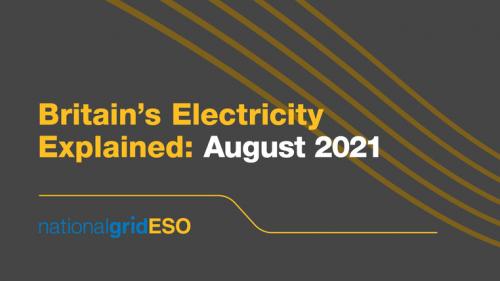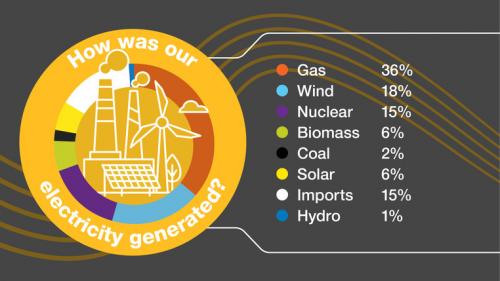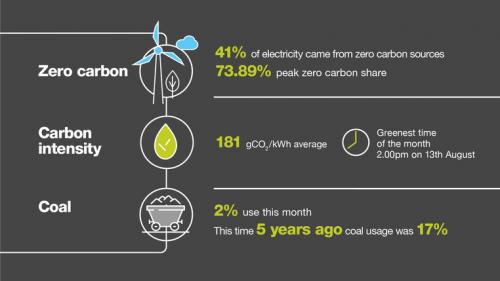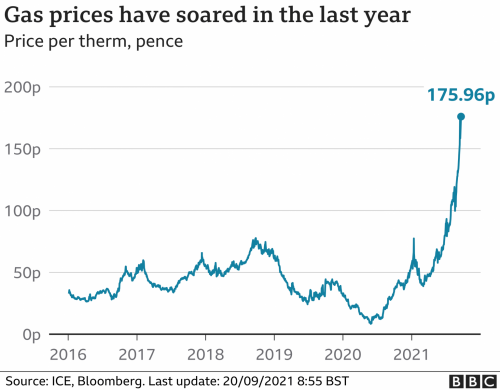
It’s all over the news at the moment about how energy prices are rising linked to increased worldwide demand on gas reserves. Part of the reason for the increased demand for gas in Europe is less output from wind turbines recently, due to a lack of wind. Calm conditions has meant wind power over the last few weeks has only made up about 7% of the U.K.'s electricity generation. This is compared to 18% for the whole of the months of August and May and 26% in February. This has meant more electricity has to be generated using gas-fired power stations to fill the gap and, also to a lesser extent, from coal-fired power stations too.
Energy sources for electricity in the UK for each month of 2021 so far
Energy sources for electricity in the UK for August 2021:



Source: NationalGridESO
U.K.’s offshore wind farms are covered by subsidies and have very low running costs once set up, however, gas is not subsidised and increased demand worldwide is pushing up the wholesale price of gas. Gas is the biggest source of energy used to make electricity in the U.K., followed by wind, imported electricity or nuclear, depending on how windy it is, with coal making up only 3% of U.K electricity generation. EDF was recently forced to restart the West Burton A coal-fired power station in Nottinghamshire to meet electricity demand with the shortfall from wind power.
Coal will be phased out in the U.K as an energy source to produce electricity over the next few years, with a deadline to close all coal-fired power stations by 2024.
The lack of wind and increased competition for world gas reserves as the Northern Hemisphere approaches the colder months and demand increases to warm buildings has caused electricity and gas prices to skyrocket. As a result, suppliers will pass on the higher costs to the consumer, so energy bills will go up for many households from October.

With the push to increase renewable energy sources and a move away from burning fossil fuels, it’s a fine balancing act with renewable sources to meet demand when there will be less and less traditional dirty sources of energy to fall back on as countries decarbonise. Electricity generation from wind turbines is reliant on the wind blowing, electricity from solar farms is reliant on the sun shining, while hydroelectricity is reliant on sufficient flow in the rivers that power the turbines.
Wind, solar and hydro energy can be sensitive to fluctuations in the weather. There have been some studies suggesting climate change may reduce wind in some parts of the world. In the northern and mid-latitudes – including the UK and Europe, the major driver of wind is the temperature difference between the arctic and the tropics. With the arctic warming rapidly, this temperature difference is becoming smaller, which means winds may, on average, become less strong.
Also, climate change may be changing weather patterns globally, with the jet stream becoming slower, weaker, more wavy and meandering – as the temperature gradient reduces between the arctic and tropical latitudes. This weakening of the jet stream means longer periods of blocking high pressure moving little over mid-latitudes while areas under troughs either side of these blocking high pressure ridges see prolonged unsettled weather.
High pressure in summer can be good for solar power generation with the sun shining more, but not so for wind power - with anticyclonic conditions often meaning light winds or calm conditions – especially near the centre of high-pressure systems. Long periods without rainfall under these blocking areas of high pressure leading to low river levels and reduction in hydroelectricity generation too.
High pressure has mostly been in charge over the UK since mid-August with the occasional blip, so winds have been light and wind power generation has been generally low across the UK’s offshore wind farms – which generate most of the wind energy.
The two 1000mb pressure anomaly charts below for the 2nd half of August and September up until the 19th show high pressure (orange/red colours) dominating UK weather and bringing low wind energy

.gif)
However, from mid-week, high pressure which has been in control to start the week, bringing light winds, will retreat back to the southwest. This will allow the jet stream, which has been generally diverted away from the UK, to move across northern Britain from Wednesday onwards, bringing fairly deep areas of low pressure east just to the north of the UK – meaning it will turn increasingly windy at the surface, especially in the north. Into next week it looks like a strong westerly jet stream will sink further and further south as the week progresses, so generally windier for all. But to be expected as we head deeper into autumn, with the polar vortex strengthening, the arctic getting colder which will, in turn, increase the temperature gradient in the mid-latitudes and bring the typical autumn depressions with gales.
GFS Ensembles show wind increasing in speed for the rest of this week and remaining windier than recently:
The wind will be back and with it, plenty of green electricity generated by it. Wind power generated 24.8% of the UK’s electricity supplied in 2020, the second largest source of electricity in the UK after gas. But back in May this year, a new record was set for the generation of electricity from wind power, when widespread gales across two-thirds of the UK during the morning of the early May Bank Holiday saw 62.5% of the electricity produced in the UK provided by wind turbines.
So, it’s important that the wind blows often!
Loading recent activity...